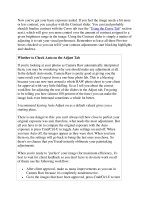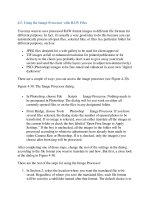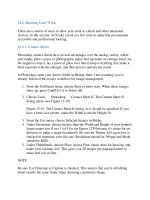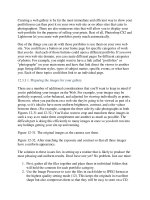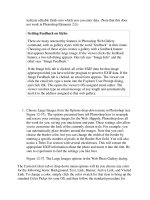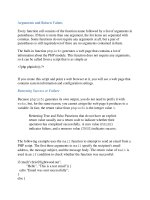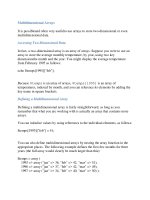Professional Information Technology-Programming Book part 6 ppsx
Bạn đang xem bản rút gọn của tài liệu. Xem và tải ngay bản đầy đủ của tài liệu tại đây (28.46 KB, 5 trang )
2.2. Take Along the Basic Accessories
If your DSLR is just too clumsy to keep around your neck all the time, get your
hands on a prosumer pocket camera that has a 7 MP sensor, a 3:1 optical zoom, has
full manual controls, and shoots RAW files. As soon as I see one that also has
image stabilization and is waterproof, I'm going to buy it.
The other accessories are listed here in order of importance, although ideally it's a
good idea to have all of them along all the time:
Memory cards and batteries
Memory cards and batteries are two things you should collect more of any
time there's a bit of spare cash in your account. Having plenty of both is
simply insurance that you won't have to stop shooting just when you happen
on the most exciting shot of the day. Extra memory cards are also the best
insurance against card failure.
Gray card
You can get a 10 percent digital gray card for $10 that's washable and is just
small enough to fit inside your camera bag (see Figure 2-8). I bought two of
them and cut one up into 3x4 inch pieces that fit neatly in a shirt pocket.
Then, even if I don't have my camera bag along, I can just set it near my
subject and snap a shot that will then allow either Photoshop or my RAW
processor to automatically set a technically perfect white balance for all the
other pictures I've taken in the same lighting conditions.
Figure 2-8. A photo of the Digital Gray Card.
Flash
Flash is your best assurance that you'll be able to get some sort of picture, no
matter how bad the light is. You probably have one along with you even if
you haven't given it a thought: they're built into virtually every digital
camera that sells for between $300 and $5,000 dollars. However, an external
flash produces at least three times as much light and can be positioned so
that its lighting is much more flattering than anything that can be produced
by an on-camera flash.
Reflector
Anything white or silver that produces a good reflection from the main light
source can be used to control the brightness of shadows. This can make all
the difference between an image that looks professional and one that looks
like a snapshot. The sort of silver and white folding reflector that is often
used as a sun-shield for a car's windscreen folds, is easy to carry, costs next
to nothing (less than $5), and weighs next to nothing. They're also large
enough to provide fill lighting for a small group of subjects. Foam-core
white and silver boards also serve well as reflectors. Black foam core works
well for absorbing light on the shadow side of the subject and increases the
depth of shadows.
Tripod
Blurring as a result of camera movement is the most common reason for
throwing out pictures. It's important that you practice, practice, practice
holding the camera as steady as possible. I actually
know photographers who
are so good at this that they can keep a camera steady as a rock for a full
second. However, it's just plain stupid to take chances when you needn't. If
you have a tripod and you suddenly see that award-winning shot just as the
sun is setting, no problemo. If you realize you need to stop down to f-22 to
keep the grass in the foreground of your scenic sharp, no problemo. Granted,
there's not always room on your bike for a tripod, but at least you can carry
along a monopod or a clamp w
ith a pan head attached. If you can't do that, at
least look for a fence post, banister, car hood, or any other steady object. By
the way, tripods with flip-open leg extensions are faster to set up than those
that have a screw-threaded clamp. Ball heads are easier to move quickly and
work well for fashion and portraiture. The traditional pan head is better
when you have to make sure the camera is consistently level, such as when
you're shooting interiors or panoramas.
Portable hard drive
If you are short on memory cards or are going away on a long trip, it's a very
good idea to take along a battery-powered hard drive. That way, you can
download all your memory cards as you shoot them so they can be
reformatted and reused. Portable hard drives come in an ever-widening
range of prices and capabilities, and the companies come and go. A good
source of up-to-the-minute reviews and prices can be found at
www.dpreview.com.
2.3. Know When Not to Shoot RAW
I started to call this section "Knowing When to Shoot RAW," but the fact is, you
always want to shoot RAW unless there's some good reason why you can't, such
as:
Demand for an extremely fast turnaround time that simply allows no extra
time for processing in RAW, even though the latter is bloody fast these days.
Demand for the fastest sequence shooting with the largest number of
contiguous images.
JPEGs may be less work, but sooner or later, you'll be sorry if they're your only
digital negative because you can always be assured there's more creative leeway in
a RAW file.
2.4. Start in Program Mode
I've already told you why you want to start in program mode. I once worked at
Macy's assisting Stanley Ciconne, the fashion photographer. The second Stan saw
the darkroom lights come on he'd yell, "Ken, do we have images?" He was wise
enough to know that as long as there were images, we were closer to a finished ad
than without them. As long as you start with your camera's mode dial set to P (and
you've taken your lens cap off and turned on the camera), you will be able to get an
image.
2.4.1. When to Switch to Manual Mode
Switch to manual (M) mode when you know you don't want the camera to reset the
exposure because you just point the camera at something in the scene that just
happens to be brighter or darker. If I've set my camera in P mode and I have a few
seconds to check my exposures, I play back what I've shot most recently, pick the
image in the series that I think has the best exposure, then press the Info button on
the back of the camera to see what the actual exposure was. I can then switch to M
mode, set the
aperture and shutter at the successful settings, and then reset the dials
to favor shutter speed (because I want to stop motion, create a blur, or make sure
my old hands aren't shaking the telephoto lens) or aperture (because I intentionally
want DOF to be either extended or narrowed). Once I've done that, all my
exposures for that "scene" will remain consistent and I will get the results I expect.
There's another time you need to switch to manual mode: when you're shooting a
panorama or want absolute control over shutter speed for bracketing a high
dynamic range (HDR) exposure (see Chapter 11).
2.4.2. When to Use Aperture Priority
Use Aperture priority (A or Av) to make sure the aperture setting stays exactly
where you set it, no matter what happens in front of the camera. You can also use
this for bracketing in HDR mode, since only the shutter speed will change. Note,
however, that there is a greater chance that something unexpected (such as
someone popping into it wearing a white shirt or dress) could make the changes in
shutter speed less predictable.
2.4.3. When to Use Shutter Priority
Use shutter priority when you know you want to do one of three things:
Stop action
Cancel camera motion (although an image stabilizer is a better solution and,
if you have time to set one up, a tripod is an even better one)
Make sure you have a motion blur effect when the one in Photoshop just
won't cut it



